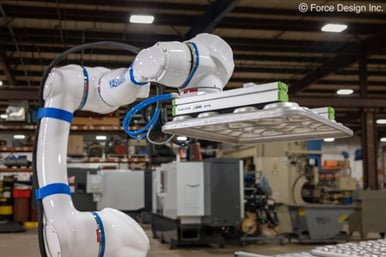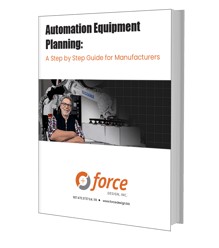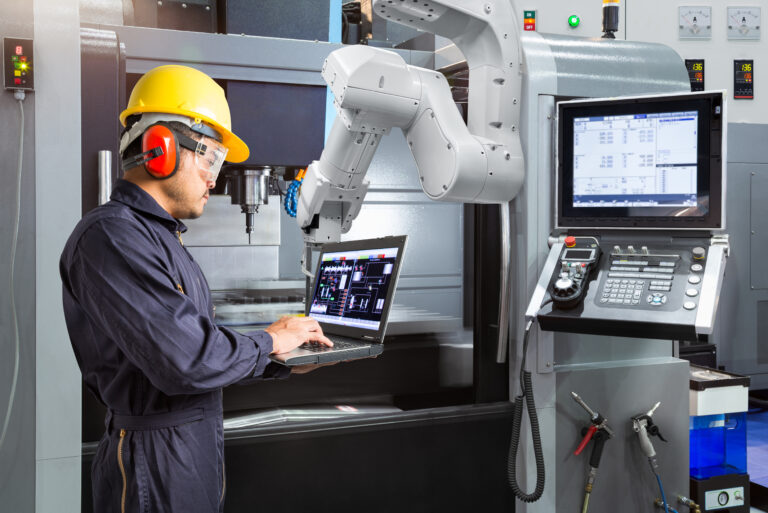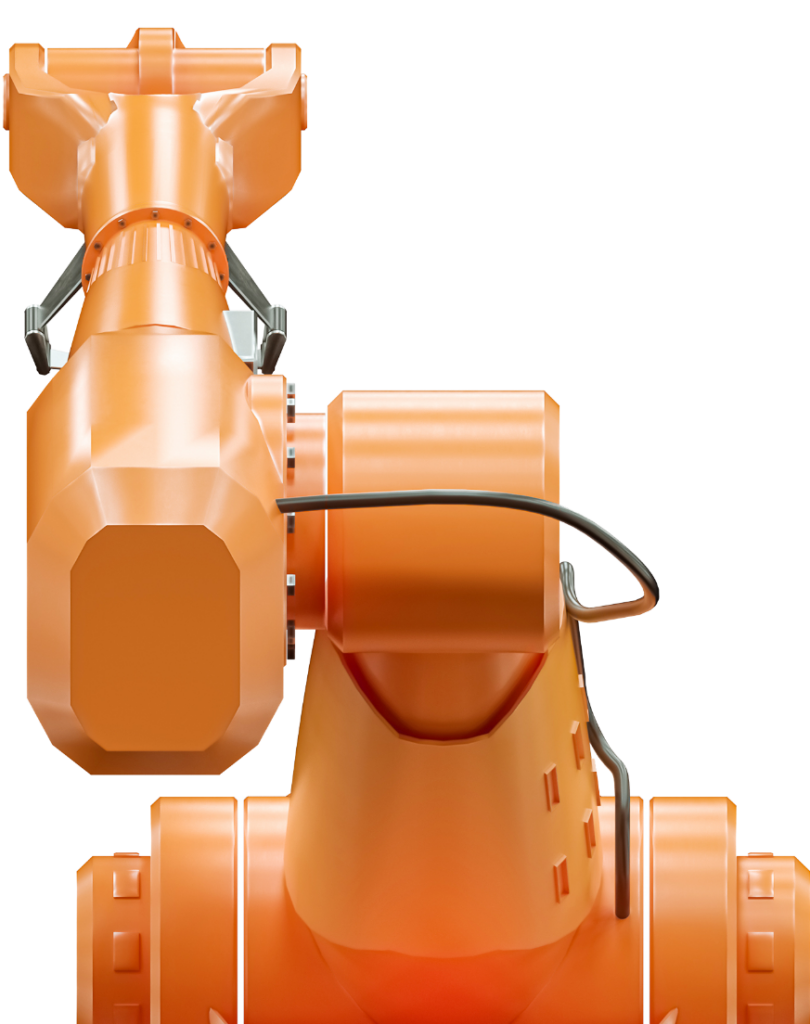When you’re preparing for a first manufacturing automation project, it probably seems like there’s always more to learn about types of robots, end-of-arm-tools, how systems come together, and all the additional equipment that comes into play. Each new example you see can simultaneously provide inspiration and leave you with even more questions.
In our experience, certain missteps and assumptions are fairly common among first-time buyers. We want to make sure this doesn’t happen to you so that your experience with automation is a positive one.
Here are some things to keep in mind as you plan your project:
1. Automation Doesn’t have to be an All-or-Nothing Choice

Sometimes we think if a little of something is good, more must be even better. So why not automate as much of a process as possible? In reality, there is usually a point beyond which the programming simply becomes too complex, or the machine becomes too unwieldly (or expensive) to do every single aspect of a task or to accommodate every iteration within a part family.
Target the oft-cited 80/20 rule instead: develop an automated solution for the tasks that make up the vast majority of the operation and leave the rest to be performed manually. For example:
Suppose most of the boxes coming through a box taping station are 12-inch cubes but periodically, a 6 x 4 x 2 box comes along. The time it takes to changeover for the smaller box size might take more time than simply taping those by hand. Plus, the extra programming and equipment to accommodate the changeover might not be worth it if the total volume is low for that size. It makes more sense to focus the equipment on that cube-shaped box since it makes up most of the work.
The goal with automation is to apply it judiciously to parts of the process where it will have the greatest impact on operations. This often means focusing on tasks you do frequently enough that the machine will run as close to continuously as possible. In short, more run time equals faster return on investment.
A related problem is the pitfall of trying to solve every productivity challenge in a single project or a single workstation. For a first automation installation, focus instead on areas where it makes the biggest difference, whether that’s increasing throughput, solving labor shortages, or improving ergonomics or part quality.
2. Make Your Expectations Clear (and Realistic)

Much frustration and dissatisfaction can be avoided when both customer and integrator have clear expectations about the project. After all, the last thing either party wants is a machine that sits unused in a corner of the facility gathering dust because it doesn’t do what the customer wanted.
The great advantage you have is your familiarity with your processes, the components you make, the tolerances and quality issues involved, and any challenges workers experience with the tasks. Be sure to share this expertise with the integrator along with the outcomes that you need, such as higher throughput, less manual labor, or higher quality.
There are several things you can do to communicate expectations so your integrator understands the goals for the project:
- Share the details and your insider “tribal knowledge” of the tasks to be automated including materials, prep/set up, cuts, assemblies, overall workflow, etc.
- Note the quality and other requirements for outputs.
- Prepare a detailed RFQ that covers your specific needs and goals.
- Focus on the outcomes you want rather than the specific type of robot, ancillary equipment, or machine capabilities required to do certain tasks.
- Be clear about your budget limitations and goals for ROI:
- Keep in mind that the best system for your needs may not be available for a rock-bottom price.
- Cutting too many costs might result in a system that misses the mark.
- Remember that problem-solving and programming, not just equipment, add expense but are vital to making a machine that you’ll use and get a return on.
3. Automation is not Necessarily a One-for-one Swap

There is often more than one way to accomplish a task, and the way something is done in a manual process may not be how it works best in an automated process. Sometimes components, assemblies, parts, or steps must be tweaked in order to translate it into work a robot can do.
In some cases, it might become necessary to make the operations preceding the automated workstation more precise. For example, if a manual assembly process requires some wiggling to get the pieces to come together, even the most advanced and dexterous robot won’t be able to make those same on-the-fly movements and adjustments. That doesn’t mean the task can’t be automated, but it might be time to revisit upstream processes to get more consistent inputs.
The benefit to working with an integrator is that they bring fresh eyes to the situation and can find new ways to accomplish the same outcome by examining:
- Inflow/outflow patterns
- Existing and potential bottlenecks
- Cycle times
- Access points for welding and other operations
- Adding barcodes to facilitate tool changeover
If it sounds daunting, just remember that you don’t need to figure out how to do it or what equipment is needed. That’s where industrial automation services come in. As long as you communicate to the integrator all the details of the process and what you must get out of it (e.g. a bracket with a 3/8-inch hole in the center or a spot-welded frame), the integrator can determine the best way to accomplish it.
4. Don’t Underestimate the Cultural Shift

With the higher throughput, improved quality and better ergonomics automation brings, it can be hard to see much of a downside. But workplace culture in the age of manufacturing automation is a complex issue, as we’ve written before.
One of the biggest concerns many employees have surrounding automation is the fear that robots will take their jobs. And perhaps the biggest concern decision makers have surrounding automation (after the expense) is how to deal with those fears.
We suggest adopting a policy of open communication and active listening from the outset. Allow workers to express concerns and take some time to explain what the new automation will actually look like (i.e. the machines will still have human operators and there will even be new skills to learn and new responsibilities). The less information shared with workers, the more opportunity for rumors and speculation to take root.
In many cases, we find jobs don’t necessarily go away, but they do change. For example:
- Certain jobs can be adjusted to be less highly skilled, expanding the pool of candidates.
- High-tech machinery can make manufacturing more appealing, physically easier, and more fun.
- Some jobs gain opportunities to do different or higher level work (e.g. troubleshooting, calibration, hand-guided programming).
- Upstream operations may now require more exacting part and material prep.
- Ongoing training on new software and equipment will become a regular part of the job.
5. Strive for a Partnership

Your internal team and the integrator’s team will have more success if they develop a partnership mindset. Both teams bring different but critical knowledge to the table: you are an expert on your process, the integrator is an expert on equipment and programming options. Avoid working in silos – communicate regularly so that both teams have all the information they need. This is important for understanding goals and for verifying that the proposed system meets expectations.
Ideally, the work you do with an integrator now is the first step in longer-term planning. For example, if this initial project was focused on automating a single function, over time you may be able to expand the system to include other tasks or operations, or to increase throughput. Be sure to discuss this kind of big-picture planning early in the process.
On the flip side, stay open to suggestions from your integrator for staggering automation of a large process over time. A great way to do this is to build in options for expansion in the system, such as a cobot with higher payload or leaving space for additional programmable automation controllers (PACs) to tie in more machines in the future.

We hope this list has given you a clear picture of your role in an automation project and helps you prepare for using robots in manufacturing. If you’re not quite sure how to get started, please download our ebook dedicated to helping you take the very first steps, or simply contact us.



